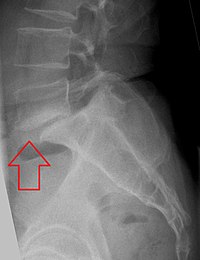
Photo from wikipedia
Study Design: Retrospective clinical study. Objective: We aimed to introduce new parameters that can better describe the pelvic morphology and lumbosacral segmental deformity in children with high-grade spondylolisthesis of the… Click to show full abstract
Study Design: Retrospective clinical study. Objective: We aimed to introduce new parameters that can better describe the pelvic morphology and lumbosacral segmental deformity in children with high-grade spondylolisthesis of the L5 vertebra: modified pelvic incidence (mPI) and modified lumbosacral angle (mLSA). Also, we aimed to establish the mLSA as a convenient, reliable measurement method and criteria to evaluate the reduction of L5 vertebral slippage. Summary of Background Data: Numerous parameters and methods exist to evaluate segmental deformity and reduction of L5 vertebral slippage, but no definitive standard for accurately and conveniently describing lumbosacral kyphosis and degree of reduction exists. Methods: A total of 24 children with high-grade spondylolisthesis (S group) and 152 children without spondylolisthesis (non-S group) underwent standard lateral radiography of the spine in our hospital between June 2009 and June 2014. We compared mPI and mLSA between the S and non-S groups. The agreement and repeatability of mPI and mLSA were also assessed. Preoperative and postoperative Japanese Orthopaedic Association (JOA) and Scoliosis Research Society (SRS)-22 scores were compared to assess clinical outcomes in the S group. The correlations between modified parameter applications and clinical outcomes were also assessed. Results: While mPI did not differ between groups, mLSA differed significantly. In the non-S group, mLSA was lordotic (25.51±6.41 degrees). In the S group, mLSA was kyphotic (25.85±5.17 degrees) before surgery and lordotic (20.74±7.04 degrees) postoperatively. The agreement and repeatability of mPI and mLSA were good, and clinical outcomes of the S group were satisfactory. Positive correlations were found between modified parameter applications and the improvement rates of JOA scores. Conclusions: mPI and mLSA can better describe the pelvic morphology and local deformity of pediatric high-grade L5 spondylolisthesis, and mLSA can serve as a useful index for correcting lumbosacral kyphosis, rebalancing the sagittal spinal profile and predicting clinical outcomes.
Journal Title: Clinical Spine Surgery
Year Published: 2018
Link to full text (if available)
Share on Social Media: Sign Up to like & get
recommendations!